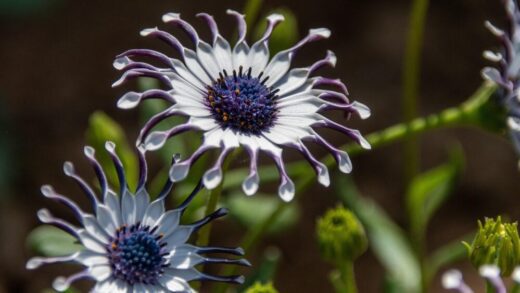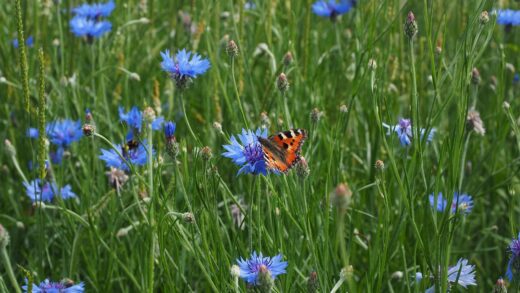Successfully guiding Hypericum androsaemum through the winter months is a crucial aspect of its year-round care, ensuring its survival and setting it up for a vigorous return in the spring. While this shrub is known for its hardiness, the specific challenges posed by winter—including freezing temperatures, cold winds, and fluctuating moisture levels—require a degree of preparation and understanding. Proper wintering is not about shielding the plant from all elements, but rather about mitigating the harshest conditions and supporting its natural dormancy process. A thoughtful approach to autumn preparation and winter protection will safeguard the plant’s health, preserving its structure and energy reserves for the growing season ahead.
The primary goal of winter care is to protect the plant’s most vulnerable parts: the root system and the crown, which is the point where the stems emerge from the roots. The roots are insulated by the soil, but in regions with deep ground freezes, this protection may not be enough, especially for younger, less established plants. The stems and any persistent leaves are exposed to the cold air and desiccating winds, which can draw moisture from the tissues at a time when the frozen ground prevents the roots from replacing it, a condition known as winter burn.
The natural dormancy cycle of the plant is its own primary defense mechanism against the cold. As autumn progresses, with its shortening days and cooler temperatures, the plant’s growth slows down, and it begins to harden off. This physiological process involves changes at a cellular level that increase the plant’s tolerance to freezing temperatures. It is important for the gardener to work with this natural cycle, for example, by ceasing fertilization in late summer to avoid encouraging new, tender growth that would be susceptible to frost damage.
The specific wintering strategy will depend heavily on the local climate and the severity of the winters. In milder regions, Hypericum androsaemum may be semi-evergreen and require very little special care, aside from a general garden cleanup in the autumn. However, in areas that experience significant frost, snow, and freezing temperatures, more proactive measures are warranted to ensure the plant not only survives but emerges from winter in good health and ready to grow.
Assessing winter hardiness
The inherent winter hardiness of Hypericum androsaemum is a key factor in determining the level of protection it will require. This species is generally considered hardy in USDA zones 6 through 9, meaning it can typically withstand minimum winter temperatures ranging from -23°C to -7°C. However, this is just a general guideline, and several factors can influence a specific plant’s ability to survive the cold in a particular garden. Understanding these nuances is crucial for developing an appropriate winter care plan.
More articles on this topic
The age and establishment of the plant play a significant role in its hardiness. A mature shrub with a deep and extensive root system is far more resilient and better equipped to handle winter stress than a young plant that has only been in the ground for one season. The young plant has had less time to develop energy reserves in its roots and is more vulnerable to both cold damage and dehydration from winter winds. Therefore, newly planted specimens always require more attention and protection during their first one or two winters.
The specific microclimate of the planting location within the garden is another critical variable. A plant situated in a sheltered spot, perhaps near a house wall or protected by a fence or larger evergreen shrubs, will be shielded from the full force of freezing winds and may experience slightly higher ambient temperatures than a plant in an open, exposed location. Conversely, a plant located in a low-lying frost pocket, where cold air settles, will be subjected to more extreme cold and may require additional protection.
The health of the plant going into winter is also a major determinant of its ability to survive. A vigorous, healthy plant that has been well-cared-for during the growing season will have ample energy reserves stored in its root system to see it through dormancy. A plant that has been stressed by drought, disease, or nutrient deficiency will enter the winter in a weakened state and will be much more susceptible to damage from the cold. This underscores the importance of good, consistent care throughout the entire year.
Preparing the plant in autumn
The preparations for winter begin in earnest during the autumn months. As the growing season winds down, one of the most important steps is to adjust the watering routine. The frequency of watering should be gradually reduced as the weather cools and rainfall becomes more common. However, it is vital to ensure the plant goes into the winter well-hydrated. If the autumn is particularly dry, provide a few deep waterings before the first hard freeze is expected. This ensures the soil around the roots is moist, which actually helps to insulate them better than dry soil.
More articles on this topic
Sanitation is another key autumn task that contributes to a healthier plant emerging in the spring. Rake up and remove any fallen leaves and other garden debris from around the base of the shrub. This material can harbor fungal spores, such as those that cause rust or leaf spot, as well as the eggs of insect pests. A thorough cleanup reduces the likelihood of these problems overwintering and re-emerging to attack the new growth in the spring. This simple act of hygiene is a powerful preventative measure.
Refraining from major pruning in the autumn is generally the best practice for this shrub. The existing stems and foliage, even if they become damaged over the winter, provide a degree of natural insulation for the plant’s crown. Pruning in the fall can also stimulate a late flush of new growth that will not have time to harden off and will be highly vulnerable to frost damage. The best time for any significant structural pruning or cutting back is in the late winter or very early spring, just before the new season’s growth begins.
Finally, one of the most beneficial preparations is the application of a layer of mulch around the base of the plant after the first light frost but before the ground freezes solid. The purpose of this mulch is not to keep the ground warm, but rather to insulate it and keep it at a more consistent temperature. This helps to prevent the damaging effects of repeated freeze-thaw cycles, which can heave the plant’s root ball out of the ground. The mulch also helps to conserve soil moisture and protect the crown of the plant.
Protective measures against frost and cold winds
In regions where winters are particularly severe, applying a protective layer of mulch is the single most important step for safeguarding the root system of Hypericum androsaemum. A generous layer, about 10-15 centimeters deep, of an organic material like shredded bark, wood chips, straw, or chopped leaves should be spread over the root zone around the base of the plant. It is important to keep the mulch slightly away from the immediate stems to prevent moisture from being trapped against them, which could lead to rot.
For younger plants or in exceptionally cold climates (such as the colder end of its hardiness range), additional protection for the above-ground parts may be warranted. A simple structure can be created by driving three or four stakes into the ground around the plant and wrapping them with burlap or horticultural fleece. This creates a barrier that breaks the force of cold, drying winds, which can be just as damaging as the cold itself. The top should be left open to allow for some air circulation and to prevent heat buildup on sunny winter days.
It is crucial to avoid using plastic sheeting or other non-breathable materials to wrap plants for winter protection. These materials can trap moisture and heat, creating a humid environment that can encourage fungal diseases. On a sunny day, the temperature inside a plastic wrap can rise significantly, potentially breaking the plant’s dormancy prematurely, only for it to be damaged when cold temperatures return. Breathable materials like burlap are a much safer and more effective choice.
In areas with reliable and heavy snowfall, the snow itself can be an excellent natural insulator. A deep blanket of snow protects the base of the plant and the roots from extreme cold and wind. If a plant has been covered with a protective burlap screen, the snow will simply add to the insulation. However, heavy, wet snow can sometimes be a problem, weighing down branches and causing them to bend or break. Gently brushing off excess snow from the branches after a heavy storm can help to prevent this type of mechanical damage.
Care during and after the winter period
Throughout the winter months, there is generally very little active care required for a dormant, outdoor Hypericum androsaemum. The main task is simply to monitor the protective measures that have been put in place. Ensure that the mulch layer remains intact and has not been blown away by strong winds. Check that any burlap screens are still secure and have not been damaged. It is also important to be mindful of winter moisture levels; while usually not necessary, a supplemental watering may be needed during a prolonged, dry, and mild spell in mid-winter.
As winter draws to a close and the first signs of spring appear, it is time to begin removing the winter protection. This should be done gradually to allow the plant to acclimatize to the changing conditions. The timing is crucial; removing protection too early can expose the plant to late frosts, while leaving it on for too long can inhibit new growth and create a damp environment conducive to disease. A good rule of thumb is to start removing protection on an overcast day once the threat of hard, prolonged freezes has passed.
The first step in the post-winter transition is to remove any burlap screens or other wraps. A week or two later, the heavy layer of mulch can be gradually pulled back from around the crown of the plant. This allows the sun to warm the soil and encourages the plant to break dormancy and begin its new growth. Some of the mulch can be left in place and spread more thinly over the root zone, where it will continue to suppress weeds and conserve moisture as the season progresses.
Once the protection is removed, a thorough inspection of the plant is in order. It is normal to see some dieback on the stems from winter damage. This is the ideal time to perform any necessary pruning. Using clean, sharp shears, cut out any dead, broken, or diseased wood, trimming back to a healthy, live bud. This cleanup not only improves the appearance of the shrub but also stimulates vigorous new growth from the base and the remaining healthy stems, setting the plant up for a successful and productive season.


















